The ‘Never-Ending’ Healing Journey Of Columbine’s Survivors
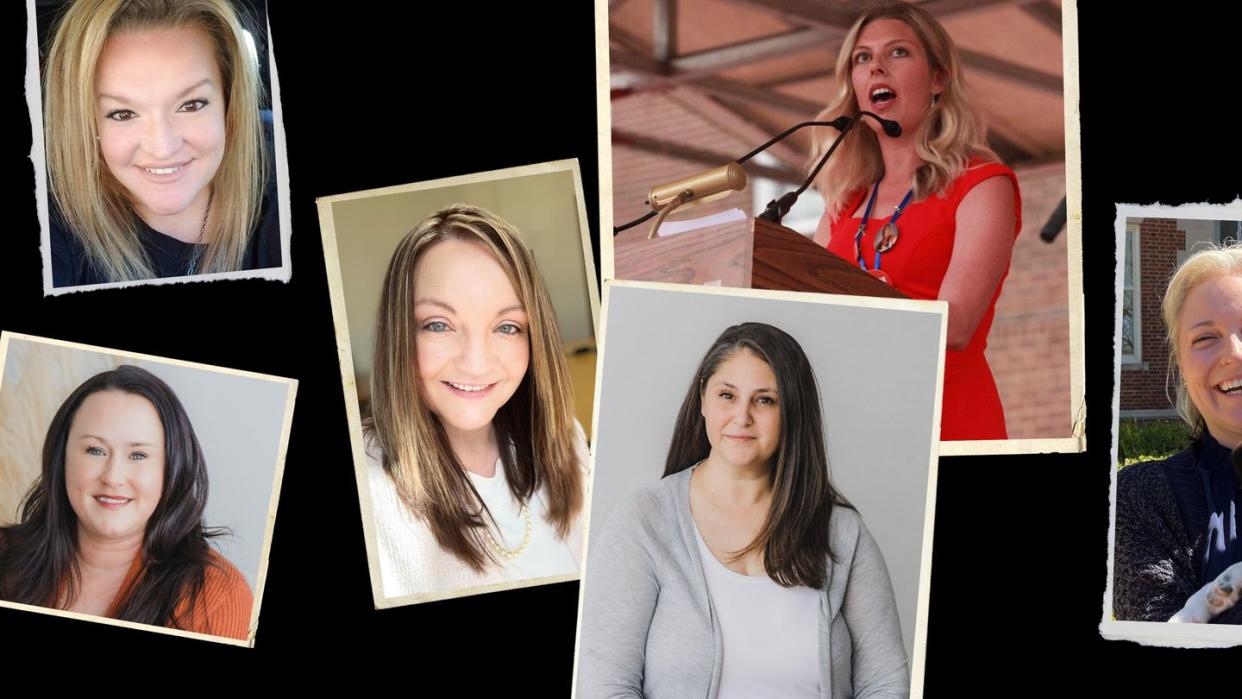
It was nearing the end of spring term. The seniors had just gone to prom. Students were busy preparing for final exams and the long summer break. They walked through the halls of their beloved school, absorbed in all the usual joys and concerns that come with the ending of the school year. Then, suddenly, their lives changed forever.
Twenty-five years ago, on April 20, 1999, two gunmen shot and killed 12 students and a teacher at a high school in Littleton, Colorado. Twenty-four other students were physically injured during the attack at Columbine High School, but the invisible wounds inflicted on the entire school community—and their families—defy measurement.
Essays From The Survivors:
Amy Over | Heather Martin Egeland | Missy Mendo | Michelle Wheeler | Coni Sanders | Salli Garrigan
But the effects did not extend only to those on the scene. The number of people affected by a mass shooting is “astronomical,” says Jillian Peterson, PhD, a forensic psychologist and executive director of the Violence Prevention Project Research Center, a nonpartisan, nonprofit gun-violence research center. In communities where a shooting took place, “you see higher levels of PTSD or acute stress reactions in people who weren't on the scene—who just identify with that community,” she says. “It’s shocking, the number of people impacted. And in many ways, we’re all impacted. When you have events like Columbine, they hit us on a national level.”
Trauma doesn’t remain within geographical boundaries either—it can trace along identity-group lines that extend far beyond the incident’s location, says Abigail Hurst, director of Trauma-Informed Programs at Everytown for Gun Safety. For example: The 2016 Pulse Nightclub shooting in Orlando had ripple effects across the broader LGBTQ community, and the El Paso Walmart shooting in 2019 had a similar impact on Latinx people, she says.
Additionally, mass shootings like Columbine end up getting replayed in the 24-hour news cycle, which seems to have a different traumatic effect, though more research into that is needed. “Columbine had such a profound impact. It hit right when 24/7 cable news was taking off, so the coverage was just constant,” Peterson says.
Survivors’ mental and emotional responses in the wake of gun violence vary significantly from person to person. But in the immediate aftermath, one in three survivors lives in fear and feels unsafe, a 2023 research report from Everytown for Gun Safety found. They also experience things like hypervigilance, numbness, paranoia, anxiety, and depression, says Hurst. Sometimes, those responses can last for decades. “It is very hard for people to truly understand the depth and the breadth of how trauma from gun violence can change [a person],” Hurst says.
Two and a half decades have passed since that spring morning in Colorado, but many people are still battling the aftereffects. Therapy, advocacy, loved ones, support groups, and sometimes medication have all helped with healing. As survivor after survivor told Women’s Health, the pain never goes away, but you adapt. You learn to live a full, joyful life with that pain.
It’s important to note that therapy and trauma counseling looked a lot different in the late nineties and early aughts as well. There was more stigma, fewer resources for survivors. So, for the six women here, the years immediately following the shooting were focused mostly on putting one foot in front of the other, trying to convince themselves, “I’m fine. I’m okay.” Healing—which is a continuous journey, they all say—came later. (Two of the women sought out mental health treatment only after becoming parents.)
“We’ve gotten, in some ways, much more comfortable in the last 25 years talking about mental health, talking about trauma, reducing the stigma around it,” says Peterson. “There’s a lot more awareness. A lot more language about it.”
Each woman here has dedicated her life to service to others—whether through helping young people, supporting other survivors, caring for children with special needs, or advocating for change at a national level. A few became teachers. One became a therapist. All have committed to sharing their stories, whether through public speeches or interviews, in hopes that they can educate people and be a resource to those who might be struggling. Every single one of them says that turning their pain into power—through advocacy work, public speaking, and connecting with survivors—has been one of the strongest therapies they’ve found for their trauma.
“Sometimes, survivors can also be the ones who can push us forward,” Peterson says.
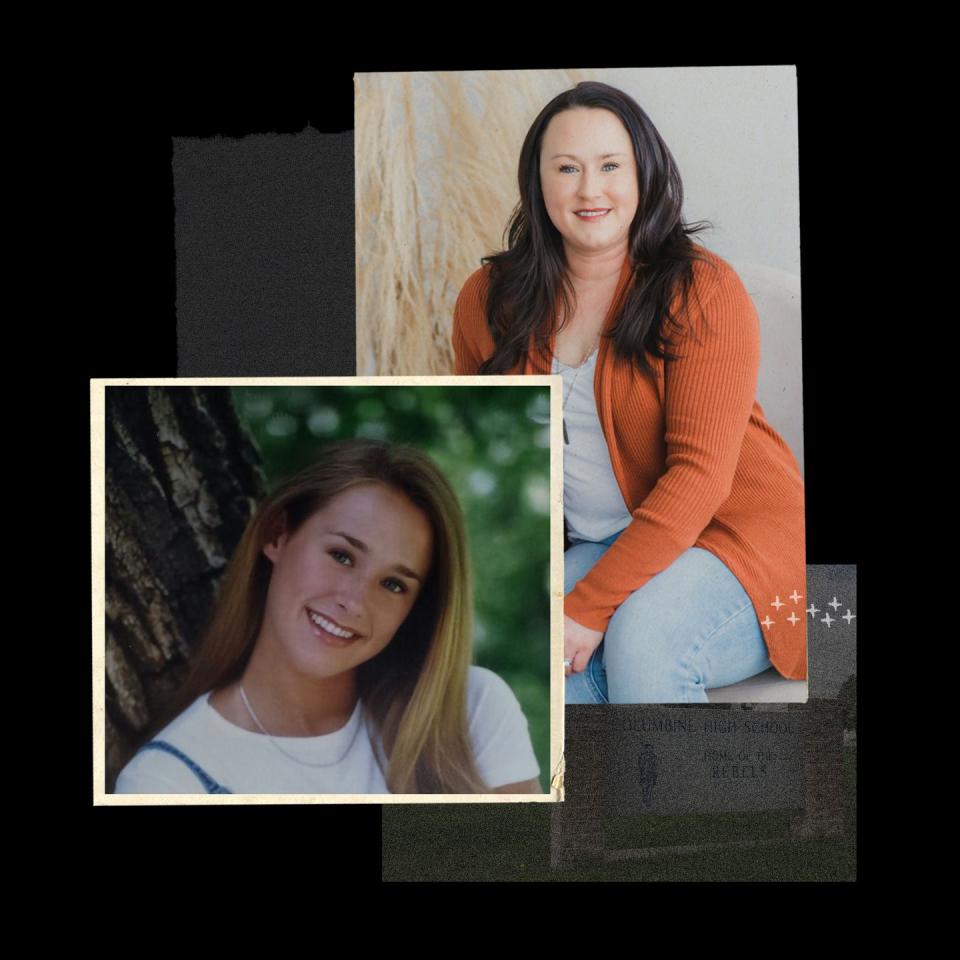
Amy Over
Amy Over was a senior at Columbine when she hid under a cafeteria table and was able to safely evacuate with other students thanks to her basketball and track coach, Dave Sanders. She now works as a paraeducator for children with special needs and founded Survivor’s Path, which brings speeches about trauma recovery and mental health to audiences across the country. Her own kids are graduating from high school this year and will be heading to their senior prom this spring.
At 43, I feel like I’ve really come into my own. I was telling my husband recently that I feel really happy in my life right now. I feel strong, physically, and I’m taking care of my mental health. I feel at peace and grounded. I also feel like I found a new purpose, working with special needs kiddos as a paraeducator. It’s a physically demanding job, but I enjoy it, and it’s good for me to always be moving.
Last week I did my first lockdown drill at school. That was very, very triggering for me. My boss was with me, and she was holding my hand, telling me, “Everything is going to be okay—you’ve got this.” But I came home and I was emotionally and physically exhausted.
The shooting was a few days after my senior prom, so there’s the “pre- Amy” and the “after Columbine Amy.” I was in the cafeteria under a table. My basketball and track coach essentially saved my life—and thousands of other lives—because he told us when to run for the doors.
In the immediate aftermath, it was just so overwhelming. I didn’t know what to do. That June, my mom scheduled a couple of therapy sessions, because we got a few for free. I lost my ever-loving mind with one of the counselors. She had started asking me really triggering questions about the shooting, and I wasn’t in a place to answer them. I became so enraged that I snapped—and ended up throwing a vase at her. I had so much anger. And from there, I kind of just coped with alcohol and partying.
PTSD creeps and seeps in years later. Mine appeared when I became a parent. I met my husband at 19. We got married at 21, and I had my daughter, Brie, at 24. I was a young mom trying to send my daughter to preschool and I was just like, “how is she going to be safe?” It wasn’t about me anymore—it was about keeping my kids safe, and mass shootings just kept happening. I remember when Sandy Hook happened, my son was a baby and my daughter was in first grade. I was on a trip with my husband in New York City. We were in Times Square, and I fell to my knees when I saw on the big screen what had happened. I called my nanny: “Where’s Brie? Where’s Masen?” I just panicked.
I started feeling like I was having a heart attack every day, and I began having night terrors. I wasn’t sleeping. I was just in a really bad cycle. And it wasn’t until then that I decided, “hey, I need help. I’m drowning.”
My husband helped me get on medication and found this amazing therapist—a Columbine teacher and counselor from back in the day. He knew my coach and all my peers. He was also on the forefront of EMDR therapy [eye movement desensitization and reprocessing, which is supposed to help reprocess traumatic memories]. I’m proud to say that I haven’t had a panic attack in years.
These days, I have tools in my toolbox that help me. I still do check-ins with a new therapist once a month. I make sure I sleep enough and drink enough water—that I’m taking care of my basic needs. And I also exercise every day—it’s just part of my mental health [routine]. I kickbox, I run, I do races and challenges and goat yoga. I hike and fish. I walk around my neighborhood. I still box and train with a pro boxer. It empowers me. That anger is still there, and this is a safe way for me to take out my sadness and anxiety. It’s just fun and keeps my mind active.
My kids are graduating from high school this spring, and I’m just beyond proud of them. I’m really looking forward to celebrating. But [this time] has also been challenging: My kids will be going to their senior prom soon, and that was the last time I was “normal Amy”—at my senior prom 25 years ago. It was such a magical time in my life. And Columbine was such an amazing school. So that’s going to be tough. The shooting is something that I’m not over—I’m overcoming. I’m still getting through this.
I tell my story not to make people sad, but to give them hope. I talk about Columbine because I want to talk about how I got through the nitty-gritty parts, and how I’m going to continue to take care of myself and others around me.
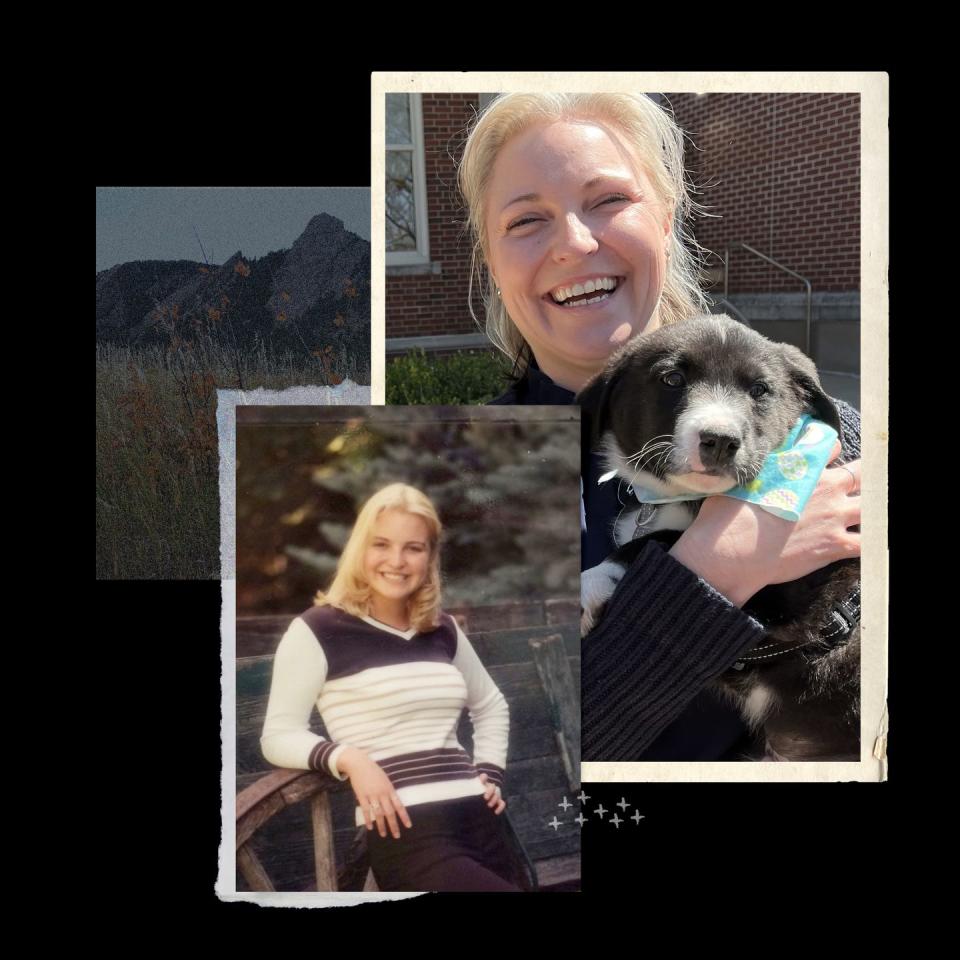
Heather Martin Egeland
Heather turned 18 two days after the mass shooting at Columbine. After the Aurora theater shooting in 2012, Heather and another Columbine survivor, Jennifer Hammer, cofounded The Rebels Project, a nonpartisan nonprofit organization named for the Columbine High School mascot, which helps survivors of mass shootings connect and find services. Heather is still the executive director and also a high school English teacher and the yearbook advisor.
The year mark—and the days leading up to it—are always weird. They’re always funky and difficult in different, sometimes unexpected, ways. And major moments in my healing journey—which has centered on peer support, advocacy, and starting trauma therapy—are also very closely tied to the big round-number year marks.
Ten years after the shooting at Columbine, I realized I wanted to become a teacher. That’s where I belonged. That was the space for me. And I don’t know if I would have become the teacher I am today if not for the events of April 20, 1999. I think I’m a better teacher because of my recovery journey.
I struggled so badly in college that I just eventually failed out. I started working in the restaurant business, but at the 10-year mark, I reconnected with all my classmates, and I decided to step down from my restaurant management role and go back to school. I finished my bachelor’s degree and got my teaching license.
While filming a documentary, [the crew] wanted to film some B-roll and asked if I would flip through my old yearbook. I hadn’t looked at it in years, and as I was flipping through, I saw that my high school English teacher had written, “I hope you major in English and become a teacher. Your students would love you.” I had apparently told my English teacher that I wanted to be a teacher, but I had totally forgotten because, well, trauma. We had graduated about a month after the shooting and, as seniors, never went back to that school.
It also took me 10 years to recognize and own the title of “survivor.” I was physically uninjured, and I wasn’t in the library. I really minimized my trauma and my experience. I was always making excuses to myself about why I shouldn’t be traumatized—because so many others had it worse, had experienced and seen worse. I felt like my trauma was not bad enough to warrant what I was feeling inside and the nightmares I was having. But at the 10-year mark, I was invited back to the school and finally got together with the Class of 1999, and I found out that I wasn’t alone in my struggles. What I was feeling was totally normal, and that peer support was a game changer for me.
I’d tried therapy one year after the shooting. Looking back, I’m really proud of my sweet little 19-year-old self, because I knew something wasn’t right. Fascinatingly, though, I didn’t think it was because of the shooting. “It’s been a whole year,” I’d tell myself—and that’s horrifying that I thought that and was putting that kind of pressure on myself. I thought it was because I was in college, dealing with whatever college kids dealt with. But I was dropping out of classes, and I knew something was wrong.
Thirteen years after the shooting, we started The Rebels Project. Another classmate and survivor, Jennifer Hammer, texted me a day after the Aurora theater shooting in 2012: “What do you think about starting a support group for survivors of mass shootings?” And I told her, “I’m in.” Two days later, we had an online platform up and running. We were desperate to help because when these events happen, it really amplifies the helplessness that I felt the day of the shooting. It’s very triggering and brings about really big emotions. This was a way that we could help, that we could give back.
Now, people find out about The Rebels Project through word of mouth—we’ve been around a long time, we’re established, and we’re trusted. And if Columbine is any indicator, we know our services are, unfortunately, going to be needed at least 25 years down the road.
At the 20-year mark, I finally started trauma therapy—like actual trauma therapy, where I did EMDR and brainspotting [therapy using spots in a person’s visual field to help them process trauma]. I had been on a planning committee for the 20-year mark and was connecting for the first time with victims’ families—and I found that I was not okay. So, I went to trauma therapy pretty extensively for about a year and a half, and now I go back a couple times a year—typically in March and April, when the year mark is approaching.
I think this year mark is going to be difficult. I say that out loud right now, knowing that next week, I’ll have a meltdown about something and I won’t know why until my husband says, “It’s April.” And I’ll say, “Oh, yeah.” I can still sometimes feel angry when I’m triggered, similar to my feelings in the months after the shooting. But now I recognize it for what it is and have learned that I don’t need to—nor should I—watch coverage of new [shooting] events. My bounce-back time is much shorter.
I would go back in half a heartbeat and change the events of that day if I could. I am also extremely proud of the person I am today, and that probably is because of how I reacted and grew in the aftermath. It took—and is still taking—time, but 25 years out, I’m just so much better and have overcome a lot.
It’s important that other survivors know that trauma is not a competition. It’s not about who suffered more and who struggled more and who experienced more. Your experience and your story are valid and real. Your trauma matters, and your experience matters, and you matter. It’s okay to cry. It’s okay to be sad. It’s okay to still be impacted. I am of course still impacted 25 years later, but it definitely gets better.
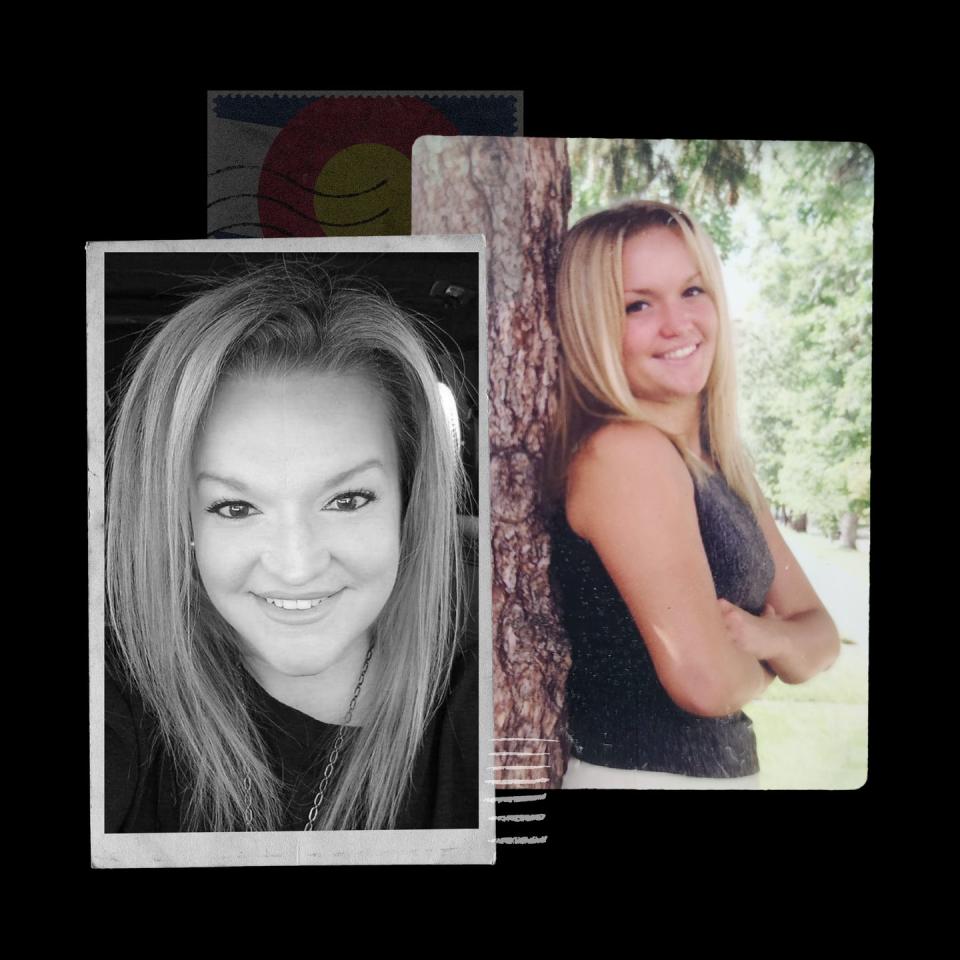
Missy Mendo
Fourteen-year-old Missy Mendo was in math class at Columbine when she heard the shooting start. She and her classmates evacuated to a park across the street where the perpetrators began shooting at them. After immediately relocating to the East Coast after high school, Missy eventually headed back to Colorado. These days, Missy works for the state of Colorado in the department of regulatory agencies and is director of community outreach for The Rebels Project.
I heard this saying once: “You never know that your experience could become somebody else’s playbook.” And these days, the ability to help someone else who may be going through something similar to what I’ve gone through—especially another mom—makes me feel strong and empowered. Talking to other survivors has helped me significantly. I say this all the time: A hug from another survivor is totally different than a hug from somebody trying to console you. It’s an unwritten understanding. They get it.
When The Rebels Project first started after the Aurora theater shooting in 2012, I couldn’t get involved because I was living on the East Coast. But I ended up moving back to Colorado, and I showed up to a silent auction the group was holding. By the end of the night, I had accepted a job as their assistant director of fundraising. It was at that point that I started to really get to know other communities of survivors—helping them connect. Now, I’ve been director of community outreach for almost six years.
Twenty-five years ago, mental health wasn’t exactly a thing. The county offered us six free therapy sessions [after the shooting], but it’s not like you could pick and choose therapists. I got a marriage and family therapist who was much older, and she and I didn’t jive very well. We weren’t a good match. At the end, I just thought, Okay, I did my six weeks, I’m okay, and then spent the next 20 years with no therapy whatsoever. No support groups, no therapy, nothing—just figuring it out on my own.
After the shooting, my sleep pattern immediately changed—I wasn’t sleeping. My brain wouldn’t shut off. I got in the habit of sleeping with the television on because it helped with the silence in my head. The news outlets kept repeating everything [about the shooting], so I started watching ESPN. I ran cross country and played soccer, and sports was the one thing that didn’t talk about what was going on in my life.
One of the hardest things to understand is that I have an unseen injury. When I read The Body Keeps the Score [by Bessel Van Der Kolk, MD], I had to put the book down because it showed scans of what your brain looks like with anxiety, during a panic attack, and when you’re distressed. For the first time, I could physically see my injury—it was nonexistent until that point. The processing that took place in the days after, before I could continue to read the book, was just hard. I am getting goosebumps talking about it now.
When I started working for The Rebels Project, I put so much pressure on myself to say the right things to these communities, to do the right thing and make the right suggestions. I was afraid any mistake would set them back emotionally or retraumatize them. And I realized: If I’m seeing the same things in myself that these other people are going through, and they’re in therapy… I don’t want to project this onto my child; I want to set her up for success in this world as much as I possibly can. And I’ve been in therapy now for over four years.
The toughest connections I make are with other parents who say, “My kid just went through this. They have to go back to school, but we’re having a really hard time. I don’t know what to do.” It’s the hardest [question] to answer because how do I tell a mom that I’m 25 years out and I’m still struggling? How do you tell them there’s no quick fix to this? You can’t tell them that there’s going to be severe challenges their entire life, and you can’t tell them that everything is going to be okay. In the 25 years that I’ve been a survivor, I have never met another survivor that was like, “Yep, I’m good. No problems.”
The trajectory of my life completely changed that day at Columbine. But over the years, I’ve come to realize that I have the capability of letting somebody else know that they’re not alone in the world, and make them feel like they have a support system. I’ve noticed a change in myself: I’ve come to realize that even though you are a tiny speck on this planet, you can still make a difference.
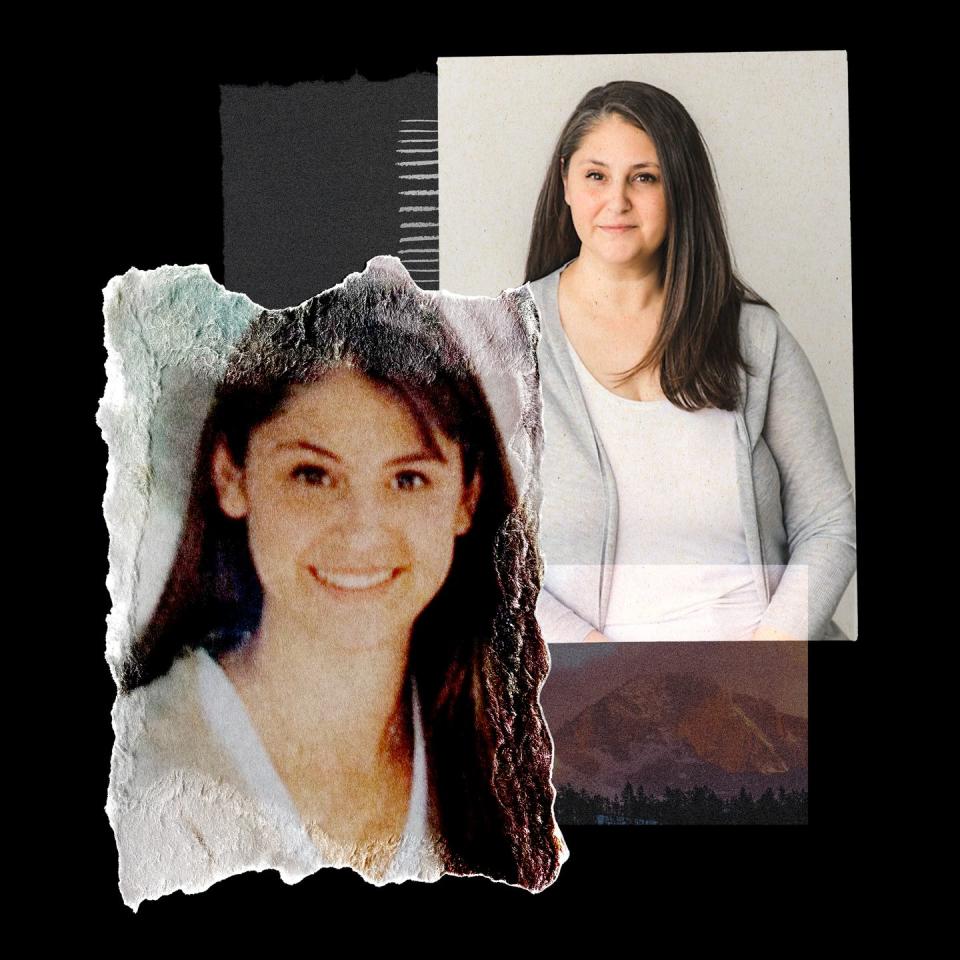
Michelle Wheeler
Michelle Wheeler was a senior at Columbine when the shooting occurred. She was in the choir room and hid in the auditorium until she could evacuate the school. Ninety-six bullets passed her body as she fled the building. She worked for nearly two decades as a preschool teacher before becoming an instructional coach at district schools, helping preschoolers through trauma and crisis. After spending time at The Rebels Project, she now works with Survivor’s Path, speaking to audiences about trauma recovery and mental health. She is still married to her college sweetheart, who unknowingly saved her life when he asked her out on a first date.
When I work with parents of survivors, I try to have them understand that their kids are not going to be the same as they were the day before. That child is dead, I tell them, and you need to grieve the loss of the child you once had and learn to love and understand the child you have now. Because we do change. And we are angry. And we’re going to take it out on the people that we love the most, because they’re the safest. That child is going to be different in school. If they’re an athlete, they’re going to be different at their sport. They’re just going to be different. Their brain has changed, and there’s really no going back to the person they were. But there’s also so much joy and triumph in the person they will become. It takes time, and it’s a very rocky road, but you will get there.
In high school, I was the class clown. School was hard for me. I don’t know if I would have had the same life if I hadn’t gone through what I did. I think I would have been a teacher, but I don’t know that I’d have worked with the population [of kids] that I work with now. I grieved the person [I was on] April 19, 1999, many, many years ago, and have let go of who she could have been. I worked on understanding who I was after April 20, 1999—loving the awkwardness and the dark humor and the sadness and the celebrations. It took many, many years to accept who I am.
I was upstairs in the choir room when the shooting began, and hid in the auditorium for what seemed like forever—but I think it was only a couple minutes. When I exited the school, about 96 bullets passed my body. None hit me, thank God. I made it out of the school probably 10 or 15 minutes after everything started.
I was a senior at the time, and I went straight to college the next year. Now that I look back on it, I can see [my] patterns of destruction. I was drinking alcohol. I had a lot of anger issues. I liked the thrill of trying to get away with things and made poor decisions that could have put me in danger, because I felt this invincibility—like, this [mass shooting] happened, I can survive anything. But when we had our first fire drill in college, I hit the ground. I panicked. And I remember thinking, This is really weird. There’s something wrong with my heart.
It wasn’t until my third year [of college] that I hit rock bottom. I was—unconsciously, but consciously—saving medication to kill myself. I just didn’t have any feeling in my body; I felt numb. Nothing excited me. I thought, Well, if this is life, this isn’t worth living. I had a plan. But the night I chose to do it, my now husband asked me out on our first date, and I finally felt something different. (We kept going out on dates, and have now been married for 20 years.)
That was my turning point. That was my realization that I wasn’t well and that I needed help. So, I went to therapy, and have done extensive therapy since then, including four rounds of EMDR, which has helped me process the sounds and the smells and the tastes I experienced in my flashbacks. I was lucky to find my husband when I was fresh in my trauma because it meant I didn’t have to explain that I was a Columbine survivor, and that I don’t like loud sounds or blue lights. That I hate balloons and black trench coats.
But I wish I’d had family connection and support after the shooting [to help process the trauma]. I’m the baby of seven kids, and there’s a 16-year difference between me and the next oldest. And I just didn’t have that family support. I didn’t have anybody to go to the funerals with me. I didn’t have anybody I could process my trauma with. After the shooting, I went to my boyfriend’s parent’s house, then to my sister’s. And when I got to her house, my mom met me at the door with a bottle of Jack and said, “We’re never going to talk about this. If you talk about it, you’re letting the perpetrators win.” Obviously, that is horrible advice. I love my mother to death, she’s a wonderful mother, but I don’t know that she could mentally handle what I went through. I honestly think it’s a generational thing.
It wasn’t until I met my husband, and experienced that love and bond, that I realized I needed people in my corner. I needed people who love me and support me, who may not have been through what I’ve gone through, but who can sit with me on dark nights and help me through a nightmare, or walk my path with me on the day that marks the shooting every year. Someone who can understand my triggers and know when to say, “Oh, we gotta go.” I have now surrounded myself with a survivor community and created my own family that I can call when I’m in crisis. Without them, I don’t know where I’d be. I don’t even know if I’d be here.
Suicide is a scary topic, but it’s important to talk about. We lost many friends to suicide after Columbine. And now that I have come out and talked more about it these past few years, I’ve had a lot of people come up to me after panel discussions, saying, “Oh my gosh, I have felt the same way.” So, I know by talking about the hard stuff, it’s going to make a difference.
[Trauma recovery] is not an easy road. But it’s not always hard. You will find love. You will have children. (That will have its own difficulties!) But you will figure out how to manage life with your trauma. It never goes away, but you learn to live with it. You learn that some days, you can do hard things, and some days you can’t. And that’s okay.
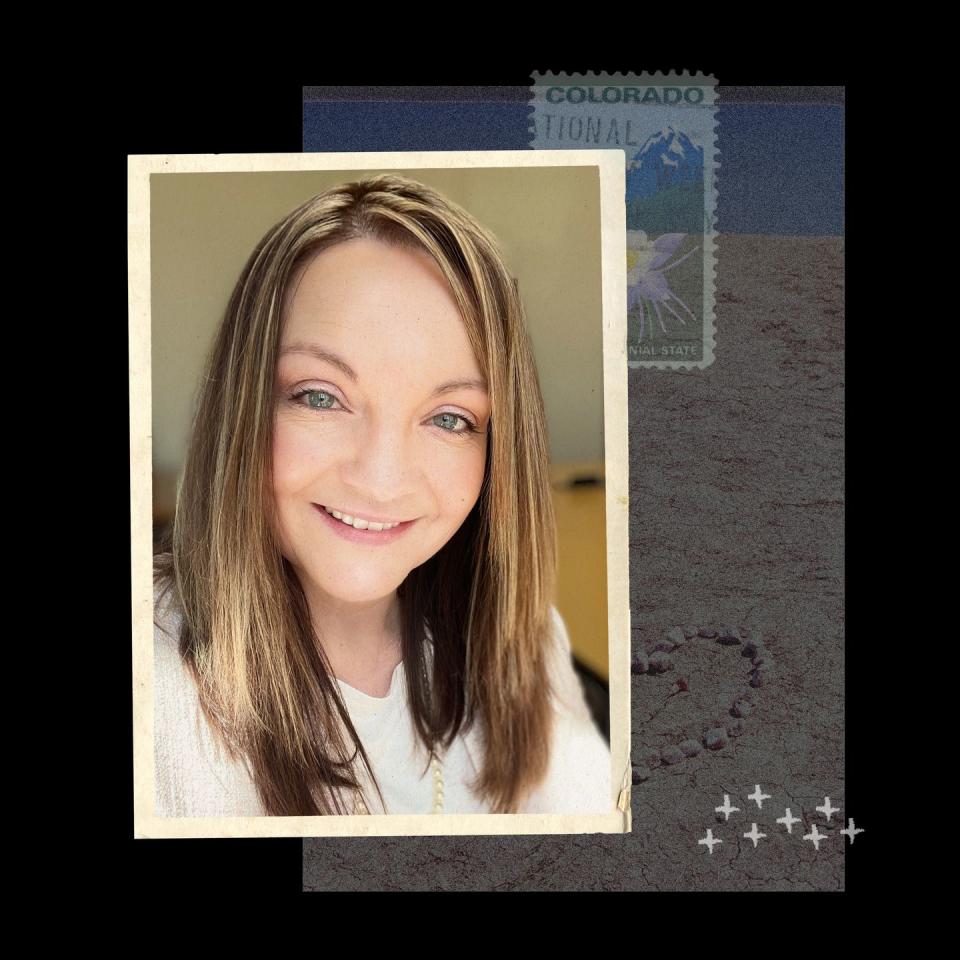
Coni Sanders
Coni Sanders was 24 when her father, beloved Columbine teacher and coach Dave Sanders, was shot and killed while trying to lead students to safety from the school’s cafeteria. Today, she honors her father and his memory through her life’s work, helping people convicted of violent crimes “find peace and live nonviolent lives.” She still lives in Littleton, Colorado, and is expecting another grandchild this year.
I’m a forensic therapist. For almost 20 years, I’ve worked with people who have committed violent crime or related harm in their communities. Working with them is such an honor. It feels really empowering when I see so many successes—see people doing the work to change their path and live nonviolent lives. Over the years, it feels less connected to Columbine and more like, “this is where I’m meant to be.” Most of my clients don’t know my story—it’s not something I openly share because I don’t want to take the focus off of them. And while I’m pretty Google-able, [my history] is kind of my secret superpower. This is where I carry on my father’s legacy by helping the struggling to find a path.
When my dad, teacher and coach Dave Sanders, was killed at Columbine High School, I was 24 years old, working at the local phone company. I was rebellious at the time and hadn’t gone to college (even though my dad wanted me to) and feeling a bit lost in my life overall. After the shooting, it felt like I was in a dream—there’s a fog and a haze [over my memories]. It was unreal. I remember the details, but I don’t remember feeling anything.
At the time, I worked in the Denver Post building, and reporters would just stop by my workplace to talk about the shooting. I had to change jobs because I just wanted to hide, to have some semblance of normalcy. I was convinced I was fine and didn’t need therapy. Everyone kept telling me “be strong,” so I was trying to do that. I tried to be tough. I wish I understood that I didn’t have to be strong; it’s not realistic that someone could “be strong” in that situation without significant support from others.
Three years later, I was driving down the highway and “Somewhere Over the Rainbow”—the version sung by Israel “IZ” Kamakawiwoʻole—came on, and I went back into that numb state. I pulled over, got out of my car, and went and sat in a ditch. And I just cried and cried and cried. When I got back in my car, I started driving really fast. And I realized I needed help.
When you’re a secondary or tertiary victim, it can feel like you don’t belong with other survivors. But these traumatic events are a wound for the entire community. That wound is seeing the people you care about suffer, the media coverage, the terror.
Three years ago, we were cleaning out my mom’s basement and found the box of evidence. It had everything—his body bag, his bloody clothes—and we all just froze. We thought mom had the police department destroy everything. It was so horrifying, and the wounds just burst open. I went and found a therapist. “I can’t manage this,” I told them.
Twenty-five years doesn’t stop the hurt. It never stops. Even right now, my whole body will go numb, my breathing changes, and I have to remind myself that I’m okay. I do grounding techniques and try to stay in the present. I sometimes hold ice cubes to help bring me back into my body. When you suffer a trauma this deep, it’s always going to be there. I’ve been in this fight longer than most people who are surviving gun violence, but it’s a less lonely journey now because so many people have traveled this never-ending path. [After a mass shooting], you step onto this path not knowing where it’s going to go. I can tell you that you’re going to fall, you’re going to get bruised. You’re going to feel lost and numb and frustrated. But you’ll also find people along that path who have experienced the same thing, who care, who are advocating for change. There’s a wide network of supporters you can really lean on.
My daughter is about to have a baby, and my dad’s not here. He was such a wonderful grandpa, and some of my grandkids aren’t going to get to experience that. I remember when I turned the same age he was when he died, I kept thinking, Oh my gosh, he had so much more life to live. And I went numb again.
Someone left a pair of shoes at the memorial, and it says, “Coach, in these shoes, you gave me wisdom. In these shoes, you made me an athlete. In these shoes, you made me a champion. In these shoes, you made me a man. My love to you, Class of ’96.” People still come up to me to tell me my dad saved generations when he saved hundreds of kids in the cafeteria. “He saved my life, and now I have a baby,” one person told me. “And my baby will one day have a baby.”
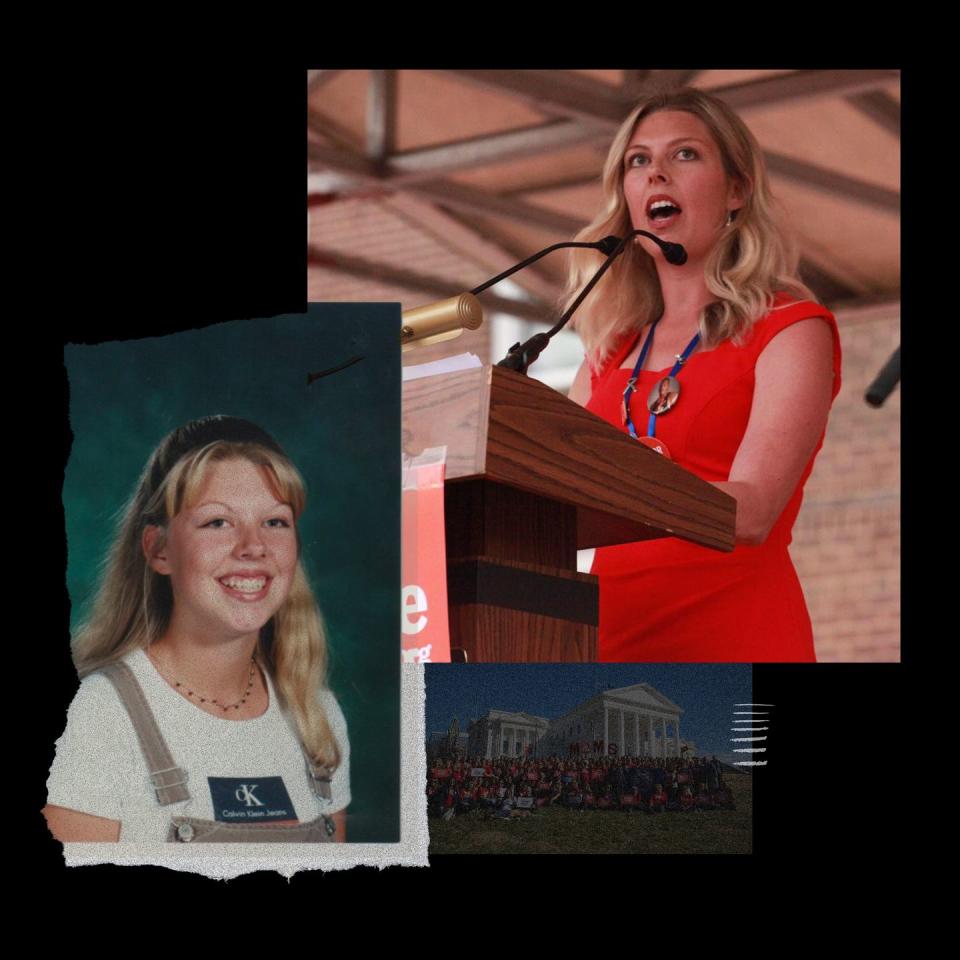
Salli Garrigan
Salli Garrigan, 16, was in the choir room when the shooting at Columbine began. Now, she has two kids—a 9-year-old daughter and 5-year-old son—and finds her strength through telling her own story. Salli is now a volunteer with Moms Demand Action and a Senior Fellow with the Everytown Survivor Network.
I loved high school. I was a truly normal teenager—if you want to call a choir-theater kid normal, which I do! I was excited to be part of the pom squad.
In the immediate aftermath, I felt a kind of grief amnesia. I was in a haze, and everything just felt fuzzy. When I look back, everything just kind of goes white, like a weird dream. I don’t truly remember things that happened during that time. We went through the motions: going to funerals, going to the hospital.
Our rival high school opened its doors to us, we got handmade blankets from Project Linus, the first responders made potpourri from the flowers at the memorial—and that outpouring was therapeutic. The community came together; the world was with us. [Knowing] that helped a lot. We had a “taking back our school” rally the next year. It felt good to be back, even though our library was taped off—it was still a crime scene—and we’d have to walk by that every day. But getting one last year with everyone, to sit in familiar classrooms again, was so helpful. We were able to make new memories, which was really important. Bringing our choir back together—and singing again—was great, great therapy.
Back then, I didn’t consider myself a survivor. I wasn’t physically injured, so I always thought, Okay, I’m fine. I wasn’t fine, and looking back now, I get that I had PTSD. Even though I didn’t know what I needed at the time, I was lucky because I found outlets like theater and singing with friends—outlets, like dancing, that were healthy. Onstage, I could pretend I was something I wasn’t. I was able to tell someone else’s story and not my own. I could hide. It was a wonderful escape. I ended up getting a degree in musical theater and moved to New York, where I went on tours and did a lot of regional theater. I never sought out therapy, but looking back, I should have. In the ’90s, therapy seemed like you failed, which is so silly [to think] now, but at the time, there was this weird stigma.
For a long time, I didn’t tell my story. But then the Parkland school shooting happened in 2018—it was eerily similar to what happened at the Columbine shooting—and that made me realize I needed to do something. I saw the kids calling themselves survivors, and I realized I could be a survivor. The Parkland kids weren’t trusting the adults [who were saying it would never happen again]. They were speaking out, and I had a moment of thinking, Why didn’t we speak out? At this point, my daughter had been born and I was pregnant with my son, and I was starting to realize my children are going to go to school, and they will see a whole different school day. I have a lot of guilt because lockdown drills happen because of our school. Because nothing changed after the Columbine shooting.
Around that time, I started getting involved in Moms Demand Action and the Everytown Survivor Network, and advocacy became an incredible coping mechanism. It was the first time I actually opened up, and it was very therapeutic to call myself a survivor, to share my story. I have [developed] other great coping mechanisms too: a sad-mom playlist that I listen to, or if I’m angry, I take a long walk so I don’t lash out at my family. It’s a lifelong grief—and you’ll be grieving in different ways, even 25 years later. You just don’t know how it will hit you. So, it’s okay to take a step back, feel all the feelings.
My daughter was with me when I was speaking out a lot about this [gun violence prevention] in D.C., so she has an idea of what happened. I tell her, “I'm working hard to keep the guns out of the hands of bad guys, so you can feel safe at school. You do the lockdown drills, you do all these things, and we’re working on it.” But I have moments where I give my kids extra-big hugs when I say goodbye to them. I want them to ask their own questions and feel what they want to feel. But it’s hard to ask, “How was your lockdown drill today?” I just wish it had stopped with us.
The six essays were condensed and edited for clarity, and were as told to Currie Engel.
You Might Also Like

